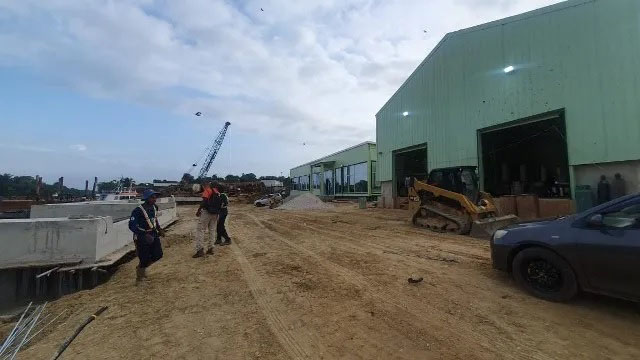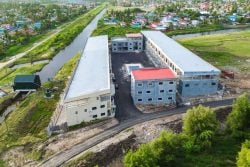-says no word yet on added costs
Public Works Minister Juan Edghill says that CEMCO Inc has acknowledged design flaws in the ongoing $1.4b Port Kaituma Stelling project where fissures occurred, necessitating remedial work.
Any additional costs are not yet clear, the minister said.
“We are now looking at the solution we think we have found. We are now remedying that. We could have been more advanced but some of the materials we have to use, we are working collaboratively to source… and I can give you the assurance it will be completed and the people will have the service they deserve,” Edghill told the Sunday Stabroek when contacted.
When asked what would be the additional costs to taxpayers he responded, “At this particular time, based upon what we are doing, I have no bill, and take my word – at this particular time, I have no bill for additional costs because we are working on the solution in the context of what needs to be done.”
He said that the focus was to first rectify the problem soonest so that the project could be delivered to the people, and emphasized that it would not be done through “any profit-making process.”
“If I pay a man something and there is a flaw in the design, doesn’t he have to bear some culpability?” he reasoned, without saying if the design firm would be asked to foot any additional costs.
He asserted that CEMCO is “no fly by night design firm” and that is why “they will have to tell me what [costs] they will bear.”
The government had been silent on the flaws in this major project until the contractor spoke about it.
On the 28th of July, this newspaper reported that contracting company, International Import and Supplies, located at Lot 15 Garnett Street, Georgetown, and owned by Parmeshwar Jagmohan, had issued a statement saying that serious flaws that had arisen in the structure were due to the poor design for the project.
The company issued the statement, it informed, with an aim to address misinformation circulating about the Port Kaituma Stelling construction project and in so doing, correct any inaccuracies and protect the company’s reputation.
According to the statement, International Import and Supplies was awarded the contract to construct the North West Stelling on December 30, 2022, through a process of public tender. The contractor’s scope was limited to the construction of the physical structure, while the design and project supervision were undertaken separately by a local consultancy firm.
It went on to assert that materials procurement and construction were conducted in strict accordance with the project specifications and Bill of Quantities, with critical elements sourced from pre-approved suppliers in Europe and China. As of February 18 this year, the project was on schedule and approximately 90 per cent completed. During the final stages of casting pile caps, fissures were observed within the backfilled area, prompting an immediate cessation of work and notification to the consultant and the Ministry of Public Works. Initial investigations indicated that the tie rod strength specified in the design was inadequate.
At this point, an independent third-party firm was engaged to review the initial design, revealing additional deficiencies in the design, particularly in the affected zone of the structure. The Ministry retained this firm to conduct a new geotechnical survey and prepare a revised design.
The new independent design has been completed, addressing the deficiencies identified in the initial design, which includes the implementation of longer and thicker piles and tie rods. These items, the release disclosed, have already been procured, and preparations are underway to resume work on the project.
Design given
Edghill echoed the contractor’s position. “It was clear that the contractor executed the job based upon the design given. The design was done by a consultancy firm who also supervised the construction. At the end of the construction of that section which was done under the supervisory eye of the design firm, there were some problems where the tie rod burst. We engaged consultant, contractor, and the contractor was even allowed to have an advisor to look at the project and we examined all the possible ways that could have led to that; the bore hole testing, the strength of the steel….”
He disclosed that to rule out the possibility that the contractor had used substandard materials, in the form of “inferior steel,” tests and samples were taken and sent abroad as the process cannot be done here.
“At one time we sent overseas for these and results showed that there was nothing wrong with the steel. We just had movement in the area which was not catered for that the bore hole brought up in the area,” the minister explained.
Prior to the statement by the company, there had been no known public acknowledgment by the Ministry of Public Works of the Port Kaituma stelling problem and Edghill said that he had not said anything as they were working to address the issue.
In January this year, Edghill cited the Port Kaituma stelling as one of four major stelling projects for completion during the third quarter this year and two months later, the Department of Public Information (DPI)
reported that the project was 85 per cent complete.
The claim by the contractor that the design was flawed will add to ongoing concerns that there is poor designing, constructing, and supervising of some of the major projects that are underway. In this case, the need for a redesign will likely come at an extra cost to the state.
Not the first
It is not the first time that there has had to be remedial works done to stellings being built here as dating back to 1997 a similar situation was faced when the Charity Stelling was being constructed.
Then, the PPP/C Government had contracted P. V. Sanasi and Associates to undertake the design of a revetment and wharf for Charity on the Pomeroon River. The contract for the construction services of this facility was awarded to Moen Inshanally. Construction of the facility commenced in late April of 1997 with works substantially completed by mid-August of the same year.
However, when the project was nearly completed, a part of the facility collapsed and the project had to be remedied, costing taxpayers millions in additional costs.
“The collapse of the revetment and wharf resulted directly from a deep-seated slope failure at this site. This slope failure was caused by the high porewater pressures and remolding of the very sensitive silty clay with organic soil, induced by pile driving. The remolded soil strengths were inadequate to ensure the stability of the critical slope at the site; slope failure therefore resulted. The slope failure plane passed below the base of the revetment. The revetment was, therefore, displaced as a result of the slope failure. Wharf collapse occurred since the lateral resistance of the greenheart timber piles was less than the lateral forces imposed by slope failure,” a report on the collapse had found.
According to the report, the design consisted of a revetment of 12-metre-long steel sheet piles driven to depths of approximately 11 metres. The design drawings further indicated the steel sheet piles were to be tied back to greenheart anchor piles sited four metres from the revetment. The greenheart piles were designed to be 12 meters long. A relieving platform, approximately three meters wide and supported by 12-metre-long greenheart timber piles, was designed to be sited between the revetment and the anchor piles. The relieving platform was designed to support loads exerted by a one meter thick fill placed on its upper surface.
A contiguous timber wharf was designed to be sited upstream of the revetment. This wharf was to consist of a greenheart timber deck supported by greenheart timber piles approximately 21.5 meters long.
It was noted, in the report then, that the contractor subsequently introduced one modification to the design during project construction. This modification incorporated six-metre-long anchors as opposed to the four- metre-long anchors proposed by the design engineer and so enhanced the function of the revetment anchor system.
“The contractor reported excessive settlement magnitude (12.5cm) on August 05, 1997. Signs of slope failure were observed around August 15, 1997. The signs included, tension cracks on the ground surface and displacement of the wharf and revetment. No corrective action was taken after the contractor’s initial report or after signs of slope failure were evident,” the report had stated.
The signs of slope failure were followed by a complete slope failure and significant displacement of the revetment and wharf on August 18, 1997. The slope failure was evidenced by a drop of the ground surface, immediately downstream of the revetment, of approximately one metre and a massive slide scarp landward of the revetment anchor piles. The revetment and wharf also experienced significant rotation toward the river as a result of the slope failure.
The report had noted that available evidence indicated the slope failure occurred at a low tide. Subsequent to slope failure, the entire revetment and wharf experienced further displacement and rotation and sank below the low tide level of the Pomeroon River. Surveys and sonars had been unable to discern whether these structures lie on the river bed.
After the initial slope failure and displacement of the revetment and wharf, Ground Structures Engineering Consultants Ltd had been retained by the Ministry of Public Works, to provide remedial works which included drilling “five borings to depths of 25 meters or to refusal within the vicinity of the failure. Recover both disturbed and undisturbed samples at discrete intervals from all borings,” the report had said.
Then in 2010, during the building of the roll off-roll on stelling at Good Hope/Supenaam, a section sank with the Ministry of Public Works then saying that it was a “mistake” during installation that had caused it. That mistake came with an additional $67.5 million price tag to taxpayers.
Blame was traded between the Ministry and the contractor BK International on responsibility for the sinkage. Then Minister of Public Works Robeson Benn had said that the Ministry of Local Government had supervised the construction of the Pomeroon/Supenaam ferry stelling and later issued a certificate of completion to BK International, even though the completed project had obvious defects.
Edghill said that he has given specific instructions as it relates to costs for the Port Kaituma Stelling.
“My clear instructions were… we have to get it fixed and don’t discuss [with] anybody seeking to make a profit off of this because if the mistake is in the design, we have to get it fixed and we have to get it fixed now. Let us see what comes from there and that is why I said ‘At this particular time’,” he stated.






